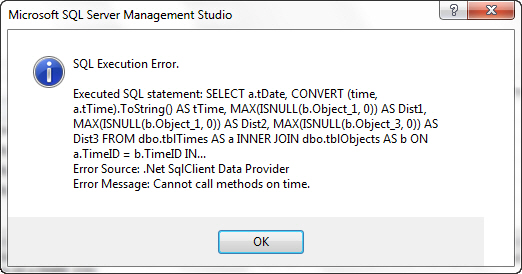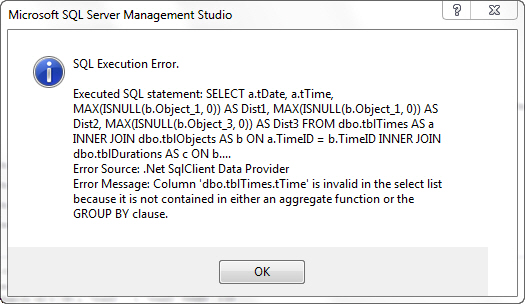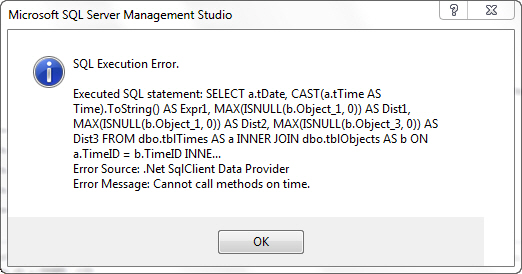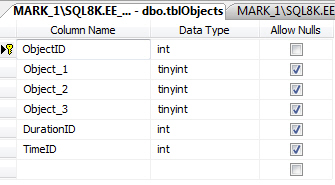Databases
--
Questions
--
Followers
Top Experts
I had to change the extension of the backup file to .txt in order to upload it to EE. Just change the extension back to .bu.
How do I resolve the error?
QUERY
SELECT a.tDate
, convert(time,a.tTime) tTime
, Dist1 = MAX(ISNULL( b.Object_1, 0 ))
, Dist2 = MAX(ISNULL( b.Object_1, 0 ))
, Dist3 = MAX(ISNULL( b.Object_3, 0 ))
FROM tblTimes a
JOIN tblObjects b ON a.TimeID = b.TimeID
JOIN tblDurations c ON b.DurationID = c.DurationID
GROUP BY a.tDate,convert(time,a.tTime)VIEW
SELECT a.tDate, CONVERT(time, a.tTime) AS tTime, MAX(ISNULL(b.Object_1, 0)) AS Dist1, MAX(ISNULL(b.Object_1, 0)) AS Dist2, MAX(ISNULL(b.Object_3, 0)) AS Dist3
FROM dbo.tblTimes AS a INNER JOIN
dbo.tblObjects AS b ON a.TimeID = b.TimeID INNER JOIN
dbo.tblDurations AS c ON b.DurationID = c.DurationID
GROUP BY a.tDate, CONVERT(time, a.tTime) bu.txt
bu.txt
Zero AI Policy
We believe in human intelligence. Our moderation policy strictly prohibits the use of LLM content in our Q&A threads.
You don't seem to be referencing tblDurations. Can this be removed?
http://social.msdn.microsoft.com/Forums/sqlserver/en-US/f987779d-3d3f-4aec-bf51-e9335f9012e2/error-in-view-when-using-convertdategetdate?forum=transactsql
If a.tTime is a Time field, try without conversion:
SELECT a.tDate, a.tTime, MAX(ISNULL(b.Object_1, 0)) AS Dist1, MAX(ISNULL(b.Object_1, 0)) AS Dist2, MAX(ISNULL(b.Object_3, 0)) AS Dist3
FROM dbo.tblTimes AS a INNER JOIN
dbo.tblObjects AS b ON a.TimeID = b.TimeID INNER JOIN
dbo.tblDurations AS c ON b.DurationID = c.DurationID
GROUP BY a.tDate, CONVERT(time, a.tTime)Otherwise, see how a CAST serves you instead of a Convert.
SELECT a.tDate, CAST( a.tTime as Time) AS tTime, MAX(ISNULL(b.Object_1, 0)) AS Dist1, MAX(ISNULL(b.Object_1, 0)) AS Dist2, MAX(ISNULL(b.Object_3, 0)) AS Dist3
FROM dbo.tblTimes AS a INNER JOIN
dbo.tblObjects AS b ON a.TimeID = b.TimeID INNER JOIN
dbo.tblDurations AS c ON b.DurationID = c.DurationID
GROUP BY a.tDate, CONVERT(time, a.tTime)Also, are you running SQL Server 2008 or SQL Server 2008 Release 2? There may be a difference in how they handle this.






EARN REWARDS FOR ASKING, ANSWERING, AND MORE.
Earn free swag for participating on the platform.
VIEW 1:
SELECT a.tDate, a.tTime, MAX(ISNULL(b.Object_1, 0)) AS Dist1, MAX(ISNULL(b.Object_1, 0)) AS Dist2, MAX(ISNULL(b.Object_3, 0)) AS Dist3
FROM dbo.tblTimes AS a INNER JOIN
dbo.tblObjects AS b ON a.TimeID = b.TimeID INNER JOIN
dbo.tblDurations AS c ON b.DurationID = c.DurationID
GROUP BY a.tDate, CONVERT(time, a.tTime)Error

VIEW 2:
SELECT a.tDate, CAST( a.tTime as Time) AS tTime, MAX(ISNULL(b.Object_1, 0)) AS Dist1, MAX(ISNULL(b.Object_1, 0)) AS Dist2, MAX(ISNULL(b.Object_3, 0)) AS Dist3
FROM dbo.tblTimes AS a INNER JOIN
dbo.tblObjects AS b ON a.TimeID = b.TimeID INNER JOIN
dbo.tblDurations AS c ON b.DurationID = c.DurationID
GROUP BY a.tDate, CONVERT(time, a.tTime)Error


Get a FREE t-shirt when you ask your first question.
We believe in human intelligence. Our moderation policy strictly prohibits the use of LLM content in our Q&A threads.
Using the Durations table for other views is fine, but the view you were creating didn't use it, so, once created, it was redundant.
Anyway, thanks again. Hope the view provides the right results.






EARN REWARDS FOR ASKING, ANSWERING, AND MORE.
Earn free swag for participating on the platform.
Databases
--
Questions
--
Followers
Top Experts
Databases are organized collections of data, most commonly accessed through management systems including schemas, tables, queries and processes that allow users to enter and manipulate the information or utilize it in other fashions, such as with web applications or for reporting purposes.



